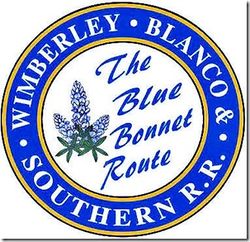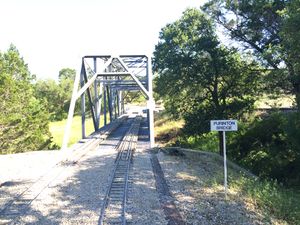Wimberley Blanco & Southern Railroad
Jump to navigation
Jump to search
The Wimberley Blanco & Southern Railroad is a private track in south Texas, owned by long-time New England live steamer Nick Edwards.
History
Bob Hornsby wrote the following on 8 April 2013:
- Nick and I moved here 15 years ago. We started the railroad in 1998. Had the grand opening in 2003. We are still adding on. Have nearly 3 miles of track on the ground and more to come. Nick and I moved here from New England. I’ve known him for 40 years.
Gallery
Purinton Bridge on the Mountain Division of the Wimberley Blanco & Southern Railroad.
More History on Dual Gauge Track
Nick Edwards wrote this description on 3 August 2014:
- Daris and Ken, kindness of Bob Hornsby, he forward your e-mails to me as you were interested in building and operating a railroad to handle 7-1/4 inch and 7-1/2 inch gauge equipment on a 7-1/2 inch gauge track. As a background, we did this for 10 years in 7-1/4 inch country in New Hampshire and have been doing it for over 12 years in 7-1/2 inch country in Texas. A few comments follow.
- We started dual gauge operations in 1980 in New England on a small 2000 foot track in Nashua, New Hampshire on an acre plus of land with a 35 foot minimum radius. The track was laid on pressure treated Southern Yellow Pine ties (2x4’s with the 2 inches exposed) using #10 sheet-metal screws to hold down the rail. We gauged the track at 7-1/2 inch as most of the equipment that would be running would be 7-1/4 inch gauge. We had many skeptics, and some of the engineers felt they could feel their locomotives “hunt” the track and complained about it. We could not feel it “hunt” on 0-4-0 switchers. Other than these complaints, we had no derailment problems. Locomotives as big as a Pennsy E-6 (4-4-2) and small consolidations had no trouble with the radius. Of course, these were mostly 7-1/4 inch locos with plenty of tolerance to run on the 7-1/2 inch track. We also ran Pacifics with no difficulty on the 35 foot radius. The diesels had no trouble that we ran.
- When we moved to Texas, we thought that we would duplicate what we did in New Hampshire on the track gauge and Southern Yellow Pine ties to a 60 foot minimum mainline radius. We learned that these Southern Yellow Pine ties would expand and contract “lengthwise” up to 1/4 inch per foot depending on the weather, which was a surprise to us. Research with Glen Conrad at Ethan Allen led us to Gene Wengert at the U. of Wisconsin (Woodweb), which then led us this knowledge of this longitudinal tie shrinkage. With a gauge overlap tolerance of around 1/8 inch for the 7-1/4 inch equipment, we learned that you need very dimensionally stable ties such as concrete or plastic ties (Trex) so that gauge would not be compromised. We are still fighting this gauge change battle, as plastic ties cost over $1.50 each, and with around 15,000 feet of track, it would cost us over $60 K (at 3 ties per foot) to convert this railroad to plastic ties, OUCH! Of note, we only use plastic ties on areas that the ties may expand and contract extensively in shaded areas that might stay wet over time and then shrink in dry weather. Now for what we did for the track.
- We use West Coast rail (I formerly owned a part of Railroad Supply Corp.) which has a curved railhead profile on 1 inch high rail and 15/16 inch foot. This helps center rolling stock assuming the rolling stock has tapered wheels. The only change we had to incorporate into the 7-1/2 inch track was in the switches. Here we had the points set at a 3/4 inch gap to allow for the back-to-back clearance of the 7-1/4 inch gauge equipment. We also milled out the frogs to 0.480 (+0.000, -0.005) flangeway width. Finally, we adjusted the gap in the guard rails to have the 7-1/4 inch trucks just skim the widened flange-way and the 7-1/2 inch trucks just miss the point in the frog. By having the guardrails assembled to the switch with horizontal bolts, we can adjust the gap if there are problems. It goes without saying that the IBLS standards should be strictly adhered to on wheel profile and gauge with some suggested changes, all within the IBLS specs. For example, we prefer to have the wheel flange radius profile at 1/8 inch instead of 3/32 inch minimum as specified in the IBLS standards. Also, we like to have 7-1/4 inch equipment wheels machined to a minimum of 0.800 inch wheel width instead at 0.750 inch as that is what a 1.6 scale wheel width would be. Otherwise, on troublesome track, some of the 7-1/4 inch equipment would fall between the rails if the wheel width was at minimum. Also, we cannot handle the old British 7-1/4 inch spec where the back-to back spec was 6-3/4 inch not 6-7/8 inch.
- If you want to see pictures of this RR, we are on YouTube and can be accessed as WB&S. Also, since we widen the flangeway on the aluminum frogs, they wear a little faster than on the rest of the track. Les Geddes in Black Hawk, CO has inserts to replace these frogs. We use RRSC frogs for # 4, 6, 7 & 9 switches and diamond crossings, and Cannonball frogs for # 8 and # 11 switches. Les also mills out custom curved frogs if you need them.
- Cheers!
- Nick Edwards
- Wimberley, Blanco & Southern RR
Videos
Ballast Tipple
References
- Track Plan and Video
- Golden Spike Ceremony Photos
- Photos
- Construction Photos
- "Texas Live Steam" video

